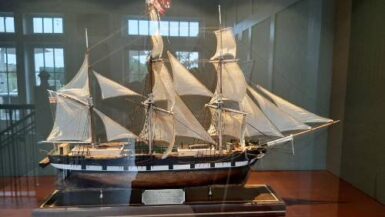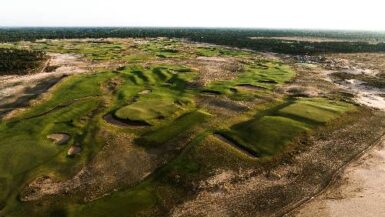
PINEHURST, NC – If I had a dime for every club in America that wanted to host a U.S. Open, I’d be able to buy Turnberry back from Donald Trump. Sadly, too many clubs spend inordinate amounts of time, energy and money in a futile pursuit of U.S. Open glory, and end up needlessly turning their clubs into unplayable torture chambers just to show how hard they can play. Usually, they get nothing in return to show for it. One club, (which shall remain nameless), just a few short miles from a recent U.S. Open host, got the worst case of golf “penis envy” in history. They had just gotten a magnificent renovation from a big name/big ticket architect only to bastardize his work by ramping green speeds to 15 on the stimpmeter, drying out the fairways and greens to crispy bacon, and making it impossible to play. All they succeeded in doing was to give the members conniptions.
“Please please please write about it in your article,” no less than eight members begged. Collectively, they said things like: “They are maintaining it too hard. We’re not good enough to play under U.S. Open conditions. It’s no fun coming here just to be tortured for five hours because the super and green committee wanted to see if they can host an Open too. I can’t bring my friends and my family to play here any more. The first time they came, they finished the round and asked me ‘You paid how many millions to do this??!!”
“I just wanna have fun with my friends!” another wailed plaintively. “It’s no fun when every hole is like number seven at Shinnecock in 2004!” referring to the fiasco that helped lead to the end of Tom Meeks’s tenure working with the U.S.G.A.
Too many courses try to emulate what they see on major championship broadcasts in an effort – almost always fruitless – to get themselves on TV. But what makes a great U.S. Open venue? There’s no better person that U.S.G.A. Executive Director Mike Davis to describe exactly what type of golf course can get a U.S. Open. In a recent interview with your author he laid out exactly what the process is in selecting a venue.
“The first thing we look at is the golf course itself. Can it be a stern enough test and exciting enough and architecturally interesting to host the World’s best golfers? Then, can it be agronomically ready in June to get firm and fast conditions?” he stated.
“Then we would look at operations, which would include the ability to stage one of the World’s largest sporting events on site. Can it fit everything? And I could go on and on about all the things we look at. Is there room between holes to move spectators? Is there acreage around the course for large compounds such as TV, corporate, and other necessary infrastructure? Then we look off site and ask where everyone parks. How do we get them to the course? Are there ample hotels and a good airport? Then we look at geographic considerations with the philosophy of wanting to move our National Open Championship around to different parts of the country. The last thing we look at is the type of course: and we have a desire to have a nice blend of private, public, and resort courses.”
Now you just don’t get to host an Open without being tournament tested. A Women’s Open or U.S. Amateur is often the price of admission to the Big Dance, and that tournament must be successful. With all that as guidance, lets look at the future venues for the Open and see what it was that caught the U.S.G.A.’s eye and earned these august venues a coveted U.S. Open date.
2015 – Chambers Bay (Washington State)
With a light that a renaissance master might have painted, the sun rises gloriously over the rugged dunescape Robert Trent Jones, Jr. designed 35 minutes outside Seattle, Washington. A true links course, Chambers Bay was a watershed moment for Jones, a game-changer moving him from a penal architecture designer to a strategic one. Puget Sound has the exact same climate conditions as Scotland and Ireland and the same native fescue grasses as well. Moreover, the site had 800 acres of sand – a true linksland course could be built in the Scottish-Irish tradition.
“I’m excited about the U. S. Open there because Chambers Bay will ask the best players in the world to think! I’m gonna get in their head and put them on the defensive, and that will separate the truly skilled players and thinkers from the home run hitters and the big-hitting linebackers masquerading as golfers. Another way we do this is to put bump-and-run shots back in play. If the terrain makes the pros think, they may freeze up,” Jones explained.
Chambers Bay richly deserves the U.S. Open, and with its sandy soil, its seaside setting with the Sound framed by fragrant, verdant tree-clothed hills, and its unique golf holes it will be a brilliant and memorable host for 2015 and (hopefully) many more U.S. Opens to come.
2016 – Oakmont (Pittsburgh)
Only Winged Foot has as much of a devastating blend of history and misery as Winged Foot.
“The members there are crazy,” said Lee Trevino. They think it’s the U.S. Open every day!” and he’s right. It’s a well known fact that if ever some unforeseen disaster forced the U.S.G.A. to move a U.S. Open on short notice, Oakmont could step in and be ready in matter of just a few weeks.
Wildly sloped, wickedly canted greens, side-hill lies in every fairway, and a cloak and dagger claustrophobia due to rough in which you could lose an ocean liner, a bulldozer, and a lunar landing module, Oakmonster lives up to its fearsome reputation as America’s toughest tournament venue, all the while being revered as a century old, Golden Age masterpiece. One of America’s most ancient golfing splendors and strongholds at once, it’s as venerable as it is difficult.
“There’s no water at Oakmont and no real forced carries. It’s just a bastard of a course,” said quintessential Pittsburgh sports writer Marino Parascenzo. “[There’s] no trees or ravines or waterfalls, but you stagger off the end and ask ‘What the hell just happened?'”
2017 – Erin Hills (Rural Wisconsin)
Located deep in “Where the hell are we, Wisconsin” golf writer Ron Whitten and architect Mike Hurdzan built a minimalist design on 640 acres of rolling, glacier and moraine impacted farmland. It’s 35 miles to Milwaukee and 15 miles to the nearest town, Waukesha.
“It’s hard,” stated Sports Illustrated’s Gary Van Sickle. “With all the enormous hills tumbling up and down, it’s one of the few courses where the players will really have to be in shape to have a chance. It’s a real test of endurance, so Kevin Stadler and Tim Herron won’t be a good pick to win.”
An unknown quantity since it’s so new, (built in 2006), the U.S. Amateur players had little trouble with it in 2011. It can stretch to a ludicrous 7,820 yards, but hopefully the U.S.G.A. will test more than machismo and brute strength. Holy Hill, with its iconic steeple provides a dramatic backdrop.
2018 Shinnecock Hills (Southampton, NY)
After Tom Meeks all but burned down the golf course, the members supposedly swore they’d never invite the U.S.G.A. back. But as Shinnecock is one of the oldest clubs in the country, a founding member club of the U.S.G.A., and hosted the second U.S. Open ever, followed by the 100th U.S. Open, a U.S. Open rota without Shinnecock is like a root beer float without the ice cream.
“Best of all, members of Shinny and/or National Golf Links of America can play 9 holes at National, leave their clubs at the turn, go to the Open, then play the last nine at National home,” said golf design expert Bruce Moulton. Sign me up for that.
2019 – Pebble Beach, (Carmel, CA)
Breaking the tradition of hosting the Open in years ending in zero, Pebble Beach will instead host the Open on its 100th anniversary.
“The two best U.S. Open venues are Oakmont and Pebble Beach,” said iconic golf writer and Golf Hall of Famer Dan Jenkins. “No other public venue comes close.”
Pebble has it all. History? How about Jack Nicklaus’s 1-iron in 1972 that lasered through a howling wind and landed one foot from the cup? Or Tom Watson’s miraculous chip-in to flat-out steal the 1982 Open from Jack after Nicklaus had charged into contention with a round that included five straight birdies on the front nine.
“You little [expletive deleted]. You’re really something,” Nicklaus told Watson when Tom got into the clubhouse.
Beauty? The rugged coastline, dew-dripped Cypress trees, and azure skies make it an idyllic paradise. There are few places that can match Pebble’s exquisite setting…Bandon, Colorado, Whistling Straits perhaps…
Difficulty? It’s windier than Chicago, the rough is clingier than a drunk sorority girl, and the greens get harder then diamonds. In 2010 only 20% of the field held the par-5 14th green with a wedge in their hands from 100 yards. Look at these scores:
Sunday in 1992: Gil Morgan (the third round leader) 81, Ray Floyd 81, Davis Love III 83, Payne Stewart 83, Scott Simpson 88, Paul Azinger 80.
I’ll take a deep breath and add from 1972: Miller Barber 80, Tony Jacklin 83, Bruce Devlin 85, Mason Randolph 85, and George Archer 87.
I’ll also mention that in that made for TV “Can an amateur break 100” dog and pony show golfer Peggy Ference got scalded to the tune of 118.
2020 – Winged Foot (Mamaroneck, NY)
It’s the Yankee Stadium of golf, but it is also the Graveyard of Champions. Just ask Phil Mickelson. Like Oakmont, there’s no water, no out-of bounds, no canyons or arroyos, and no forced carries at all. Still the numbers that get posted there look like a lotto card. Winning U.S. scores are as follows: 285 in ’06, (+5) 287 in ’74, (+7) 282 in ’59 (+2), and 294 in ’29 (+6, it played par 72 that year)). Yes in ’84 Fuzzy Zoeller won with 276, (-4), but after the “Massacre at Winged Foot” ten years earlier, if the U.S.G.A. hadn’t eased up on the throttle in Mamaroneck, the pros would have shot every blue coated, arm-banded official on site. Back then “They needed to be killed” was still a legal defense in some states. In Texas it still is…
2021 – Torrey Pines, South Course (La Jolla, CA)
Tiger’s knee-injected performance and Rocco Mediate’s swashbuckling grit turned Borey Pines to Glory Pines, but it’s still too difficult to get there, it’s impossible to move around when you do get there, and Rees Jones erased any interesting golf design features in a misguided search for fairness, (read: he thinks blind shots, uneven lies, and reachable par-5s aren’t great golf). It’s rather milquetoast when it comes to the golf itself. Still, the ocean views look great on TV. Plus Tiger likes it, and Tiger usually gets what he wants.
So there it is: a mix of resorts, public venues, and venerable old clubs, difficult, claustrophobic courses and somewhat friendlier, more familiar confines, and new faces and old friends. Tee it up boys. First one to card 280 wins the trophy.
COURSES THE OPEN SHOULD RETURN TO
Oakland Hills (Detroit) – The U.S.G.A. and PGA did a quiet trade a few years back: Oakland Hills for Bathpage Black, (yes, BATHpage) straight up. Maybe the U.S.G.A. through in a box of Titleists and a few golf gloves, but they definitely got the better of that deal. Bethpage is pretty darn good, but Oakland Hills is truly great. Moreover, Bethpage gets soaked and muddy every time a major has been played there, and the fans think they have carte blanche to interject their mouths into the proceedings. People heckling golfers, throwing up from drinking, and generally being rude, aggressive, and disagreeable is the norm, indeed encouraged by the Neanderthals at certain NYC tabloids
Olympic Club (San Francisco) – Who needs ungodly length, ubiquitous water, and an ocean view when the reverse camber of the golf holes flummoxes the greatest golfers in the World? Making the hole turn one way, but the land the other limits distance and offers a strong defense to scoring but des it in a natural and fair manner.
“Remember, there’s only one fairway bunker on course, but 40,000 trees. Many of them are down now, but no water, no o.b. Just trees, trees, trees, trees, trees,” said the Oakland Tribune and San Francisco Examiner’s quintessential sports writer Art Spander.
Philadelphia Cricket Club Wissahickon Course – The club’s St. Martin’s course hosted the 1907 and 1910 Opens, but now the Wissahickon course has been restored and redesigned as a museum piece of the greatest hole templates of A.W. Tillinghast by restoration specialist Keith Foster. The club should sweep every major magazine’s best restoration award. Moreover, with Merion far to small to ever host the Open again, Philly needs a replacement venue. The Cricket Club is far and away the best choice.
THIS ARTICLE ALSO APPEARED AT CYBERGOLF.COM
Special thanks to our sponsors this week: Seize sur Vingt clothiers of Manhattan and Los Angeles, Acey Ducey sports bar in Forest Hills, (Your Place for Sports in Queens!) and Kaplan Test Prep…for your best test scores ever, and Avis rent-a-car in White Plains. Say hi to Steve and Steve for me!








